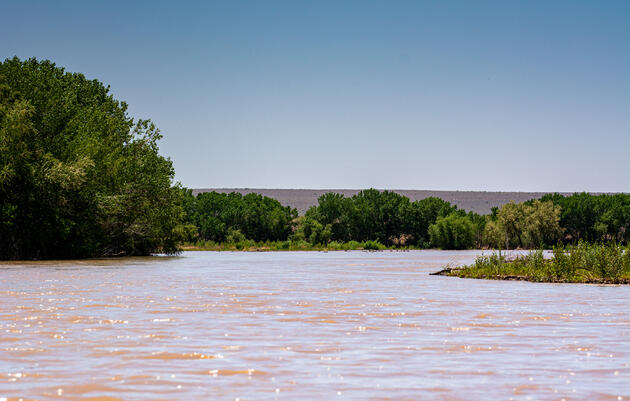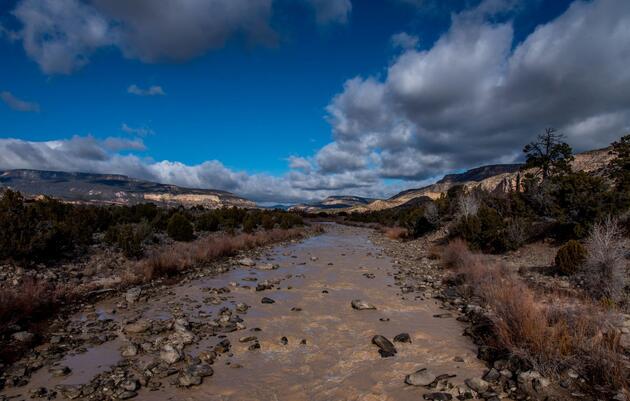Things are so much easier in New Mexico when it rains. When last you heard from me, it was July of 2021 and I was finding joy and reasons for optimism as summer rains transformed our arid farmlands into a lush green corridor and sent needed flows down the water-deprived Rio Grande. Today, following another dry spring, and the latest heart-breaking news on the Hermit Peak Fire (now at record breaking size for our state), I’m trying to comprehend the overall stressed state of our rivers and forests.
The Rio Grande is in crisis, largely as a result of climate-driven changes to the hydrology of the system. Snowpack no longer results in the amount of stream flow that it historically did; less water is making it to the river; more is evaporating and soaking into water-parched soils. A barometer of this crisis is the status of our Rio Grande compact, an agreement between Colorado, New Mexico and Texas that sets legally enforced mandates on how much river water each state can use. Today our compact deliveries to Texas continue to decline, putting us into a troubling hole that it is getting harder and harder to escape and puts water for the river and farms at risk. As the compact deficit is an indicator of our drying climate, so is the limited water availability for farmers, the declining status of Rio Grande Silvery Minnow populations, the reduced habitat for nesting songbirds, and the overall decline in the health of our rivers.
The environment has historically been an afterthought in western United States water management. In New Mexico, our rivers are treated as conduits- pipelines to “efficiently” move water downstream for “traditional” uses (farming, cities, industry, and compact deliveries). When multiple species of native fish were listed under the Endangered Species Act in the 1990’s, the flow needs of these few ecological indicators were abruptly pitted against the recognized uses of our river water. In select locations (i.e., Pecos River below Fort Sumner Reservoir, Middle Rio Grande, San Juan River), water managers have been legally mandated to provide some water to keep endangered fish populations alive. Meanwhile, the water needs for the remainder of our state’s rivers have been left out to dry.
New Mexico desperately needs and environmental flow program to address the ecological health of all our rivers and to protect them from becoming degraded ditches. Back in the day, such programs were referred to as “in-stream flow” programs and were stigmatized as a direct threat to traditional water uses. “Don’t play in our sandbox” was the prevalent sentiment (literally!). Where environmental flows have been implemented in the state for Endangered Species Act compliance, the fish vs. farmer dichotomy has largely been proven false. From the Pecos River in central New Mexico, to the Middle Rio Grande, environmental flow programs appear to only help rivers and the people that rely on them. These programs have not harmed a single irrigator, city, or compact delivery.
Environmental flows are largely non-consumptive and provide water in the river for consumptive downstream traditional uses that would not be there otherwise. Environmental water leasing programs have provided funding to farmers for taking a year off during drought and improving their irrigation systems. Reservoir management changes have returned the timing of key hydro-ecologic cues to rivers with little to no water costs, and any of these costs are compensated. These types of solutions are out there but they are often elusive and demand creativity and commitment from all parties.
Environmental flow programs require state and agency staff engagement. There are many examples of such programs in our neighboring states. Texas, for instance, has overwhelmingly recognized the economic importance of healthy river flows through a robust program consisting of rules and tools for assessing and negotiating environmental flows. Colorado’s nearly 50-year-old in-stream flow program has led to more water in 9700 miles of streams and 480 natural lakes. These programs are resourced with hydrologists, biologists, and lawyers—cross disciplinary teams that find creative, local solutions to water shortages.
Other than New Mexico Interstate Steam Commission staff working within endangered species programs, New Mexico has no staff dedicated to protecting the environmental flow needs of our rivers. Only recently through Audubon and Trout Unlimited water right permits, has in-stream flow been recognized as a beneficial use of a water right in New Mexico. An environmental flow program is not a luxury—it is an essential component to keeping New Mexico beautiful for both its residents and visitors alike.






